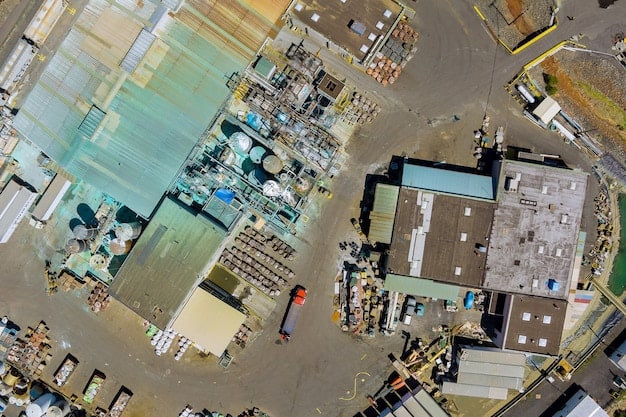Mexico’s Minimum Wage: Impact on US Manufacturing Costs?

The continuous increase in Mexico’s minimum wage is poised to significantly impact manufacturing costs for US companies operating south of the border, necessitating strategic adjustments to maintain competitive advantage and operational efficiency.
The landscape of global manufacturing is ever-evolving, and for US companies benefiting from nearshoring in Mexico, a critical question arises: Mexico’s Minimum Wage Increase: How Will It Affect Manufacturing Costs for US Companies? This ongoing economic shift demands a closer look into its multifaceted implications, from labor expenses to supply chain resilience and strategic investment.
Understanding Mexico’s Minimum Wage Evolution
Mexico has embarked on a sustained trajectory of minimum wage increases, a policy driven by a commitment to improve living standards and reduce economic inequality. This initiative, while socially progressive, introduces a complex variable into the operational calculus for multinational corporations, particularly those from the United States with significant manufacturing footprints in Mexico.
Historically, Mexico’s lower labor costs have been a primary draw for US manufacturers seeking to optimize production expenses. The proximity, favorable trade agreements like the USMCA, and a skilled workforce have cemented Mexico’s position as a vital manufacturing hub. However, the recent series of minimum wage hikes signals a maturing economic environment, one where labor arbitrage opportunities may begin to diminish or, at the very least, transform.
Recent Wage Adjustments
The Mexican government, through the National Minimum Wage Commission (CONASAMI), has steadily increased the minimum wage. These adjustments are not isolated events but rather part of a broader economic strategy aimed at bolstering domestic consumption and creating a more equitable distribution of wealth. For businesses, this translates to tangible shifts in direct labor costs.
- Since 2019, Mexico has seen significant annual increases, often exceeding inflation rates.
- The Free Zone of the Northern Border (FZNB) typically experiences even higher minimum wages due to its strategic importance in trade with the US.
- These increases reflect a governmental push for better quality of life for its citizens, impacting various sectors from agriculture to manufacturing.
The impact of these consistent increases transcends mere payroll calculations. They also influence the broader wage structure, potentially pushing up salaries for even mid-level and skilled positions as employers strive to maintain internal pay equity. This ripple effect can be more substantial than the direct minimum wage hike itself.
Furthermore, these wage adjustments are often accompanied by other labor-related reforms or stricter enforcement of existing regulations, such as those pertaining to outsourcing or worker benefits. This holistic approach by the Mexican government means that companies cannot simply view minimum wage increases in isolation. They must consider the entire labor ecosystem in Mexico.
The motivation behind these wage increases is multifaceted. Beyond social welfare, advocates argue that higher wages can lead to increased productivity, reduced employee turnover, and a more robust domestic market. For US companies, understanding these underlying motivations is crucial for forecasting future policy directions and adapting their long-term strategies in Mexico.
In essence, Mexico’s minimum wage evolution is a clear signal: the era of exceptionally cheap labor is gradually giving way to one of more competitive, yet still advantageous, labor costs. Companies that proactively analyze and adapt to this shift will be better positioned for sustained success.
Direct Impact on Manufacturing Labor Costs
The most immediate and obvious consequence of Mexico’s minimum wage increases for US companies is the direct escalation of labor costs. While often perceived as a small fraction of a worker’s total compensation due to benefits and social security contributions, the minimum wage forms the bedrock upon which the entire compensation structure is built in many manufacturing operations, particularly those employing a significant entry-level workforce.
When the minimum wage rises, companies must adjust the pay for their lowest-paid employees accordingly. However, the impact rarely stops there. To maintain internal equity and morale, managers often find themselves needing to raise wages for workers earning slightly above the previous minimum wage as well. This cascade, or “wage compression,” ensures that a perceived fair wage hierarchy is preserved within the organization.
Calculating the Financial Strain
For a US company, the financial strain is not just the difference in direct pay. It encompasses a range of associated costs. These include increased contributions to social security, housing funds (INFONAVIT), and retirement savings (SAR), as many of these are calculated as a percentage of the worker’s base salary. The higher the base salary, the higher these employer contributions become, adding to the overall cost of employment per worker.
- Increased direct payroll expenses.
- Higher social security and benefits contributions.
- Potential for wage compression across pay grades.
- Need for budget reallocation or increased product pricing.
Companies must meticulously recalculate their labor cost models to account for these changes. This involves not only the current minimum wage but also projecting future increases based on government policy trends and economic forecasts. Failure to do so can lead to unexpected budget overruns and reduced profit margins, making competitiveness difficult to sustain.
Beyond direct costs, there’s also the element of productivity. While higher wages can theoretically boost morale and productivity, the direct correlation requires effective management and training. If wage increases are not met with corresponding gains in efficiency or output, the per-unit labor cost will undoubtedly rise, affecting the final product’s price point.
The impact is particularly acute for industries that are highly labor-intensive, such as apparel, electronics assembly, or certain stages of automotive manufacturing, where the proportion of labor costs to total production costs is significant. For these sectors, even a modest percentage increase in minimum wage can translate into substantial financial adjustments.
In summary, the direct impact of minimum wage increases on labor costs is a complex calculation that extends beyond base pay. It requires a comprehensive analysis of all associated employer contributions and a proactive approach to potential wage compression, all while striving to maintain or improve worker productivity to offset rising expenses.
Ripple Effects on Supply Chains and Operations
The implications of Mexico’s minimum wage increases extend far beyond immediate payroll adjustments, creating complex ripple effects throughout supply chains and operational strategies for US companies. These effects can subtly, yet significantly, alter the economic calculus of manufacturing south of the border, demanding a holistic reassessment of existing models.

One major consideration is the potential for increased costs from Mexican suppliers. As their own labor costs rise due to the minimum wage, Mexican raw material providers, component manufacturers, and logistics services will likely pass on these increased expenses to their clients, including US companies. This indirect cost increase can impact various tiers of the supply chain, often making it challenging to pinpoint specific points of inflation.
Logistics and Hidden Costs
Logistics, already a significant cost component in cross-border manufacturing, could also see an uptick. Higher wages for transportation workers, warehouse staff, and freight handlers in Mexico will inevitably translate to higher service costs. This contributes to the overall landed cost of goods, potentially eroding the cost advantages that drew US companies to Mexico in the first place.
- Increased prices from Mexican raw material and component suppliers.
- Higher transportation and logistics expenses within Mexico.
- Potential for increased administrative and compliance costs related to labor regulations.
- Pressure to renegotiate existing supply contracts due to inflationary pressures.
Furthermore, the increased minimum wage could influence labor availability and competition. While higher wages might attract more workers to certain sectors, they could also lead to demands for higher wages in other, previously distinct, labor markets. This dynamic can complicate workforce planning and talent acquisition, especially for specialized roles.
Operational efficiency also comes into sharper focus. With rising labor costs, companies face increased pressure to optimize processes, invest in automation, and improve productivity per worker. What might have been economically viable manual processes at lower wage rates may no longer be sustainable, prompting capital expenditure on new technologies or re-evaluation of production methods.
Another subtle yet significant ripple effect is the potential impact on economic stability and consumer purchasing power within Mexico. While higher wages can boost local demand for goods and services, they can also contribute to inflationary pressures. This could affect the broader economic environment in which US companies operate, influencing local sales and market dynamics if they also serve the Mexican domestic market.
In essence, the minimum wage increases necessitate a comprehensive review of the entire operational ecosystem. Companies must look beyond their direct payroll to understand how these changes will propagate through their network of suppliers, logistics providers, and the broader economic landscape of Mexico.
Strategic Responses for US Manufacturers
Faced with rising labor costs in Mexico, US manufacturers are compelled to re-evaluate their operational strategies to maintain competitiveness and profitability. This requires a nuanced approach, moving beyond simplistic cost-cutting measures to embrace innovation, efficiency, and long-term strategic adjustments.
One primary response involves optimizing existing operations for greater efficiency. This can range from lean manufacturing principles to process automation. Investing in robotics and advanced machinery can reduce reliance on labor, offsetting the impact of rising wages on a per-unit basis. Such investments, while requiring initial capital outlay, can yield significant long-term savings and enhance production quality.
Automation and Workforce Skilling
The push for automation often comes hand-in-hand with the need for workforce skilling. As repetitive tasks are automated, the remaining human workforce needs to be upskilled to manage and maintain the new technologies or to perform more complex, value-added tasks. This represents an investment in human capital that can ultimately boost overall productivity and adaptability.
- Invest in automation and robotics to reduce labor dependency.
- Focus on upskilling the existing workforce for higher-value tasks.
- Implement lean manufacturing principles to eliminate waste and optimize processes.
- Diversify sourcing strategies to mitigate supplier cost increases.
Another strategic response is to carefully review and rationalize the product portfolio manufactured in Mexico. Companies might choose to shift the production of lower-margin or highly labor-intensive products to other regions, or even bring some production back to the US if the cost differentials narrow sufficiently. Conversely, they might concentrate higher-value, more complex manufacturing in Mexico where skilled labor and established infrastructure still offer advantages.
Diversification of the supply chain itself is another key strategy. While nearshoring to Mexico offers significant benefits, relying on a single manufacturing hub, especially one with evolving cost structures, can be risky. Exploring secondary sourcing options or establishing alternative production facilities in other advantageous regions could build resilience and provide leverage in cost negotiations.
Furthermore, companies are increasingly focusing on vertical integration or forging stronger, more collaborative partnerships with trusted Mexican suppliers. By working closely with suppliers, manufacturers can help them implement efficiency improvements, share best practices, and potentially negotiate more favorable terms, creating a mutually beneficial ecosystem.
Ultimately, the strategic responses are not about abandoning Mexico as a manufacturing destination. Instead, they are about evolving the operational model. It’s about moving towards higher-value manufacturing, embracing technology, and building a more resilient, efficient, and strategically sound presence that can adapt to changing economic realities while continuing to leverage Mexico’s unique advantages.
Comparative Analysis: Mexico vs. Other Manufacturing Hubs
In light of Mexico’s rising minimum wage, US companies are naturally prompted to conduct a comparative analysis of manufacturing costs and advantages against other global hubs. While Mexico’s attractiveness remains strong due to its proximity and trade agreements, this evolving labor cost structure requires a fresh look at the competitive landscape.
Traditionally, Mexico has offered a compelling blend of geographical convenience, lower labor costs than the US, and a skilled workforce, especially in sectors like automotive and electronics. Its participation in the USMCA provides significant customs advantages and supply chain efficiencies that overseas alternatives cannot match.
Evaluating Nearshore vs. Offshore Advantages
When comparing Mexico to traditional offshore manufacturing giants like China or Vietnam, several factors come into play. While Asian economies might still offer lower direct labor costs, especially for high-volume, low-complexity goods, the total cost of ownership often tips the scales in Mexico’s favor. This includes:
- Significantly reduced shipping times and costs from Mexico to the US.
- Lower inventory holding costs due to shorter lead times.
- Reduced geopolitical risks and easier regulatory compliance compared to distant markets.
- Cultural alignment and ease of communication between US and Mexican teams.
Despite rising wages, the overall “supply chain premium” associated with offshore manufacturing—including longer lead times, higher logistics costs, and greater vulnerability to global disruptions—often offsets the direct labor cost savings. The recent global supply chain upheaval has underscored the value of nearshoring, making Mexico an even more strategic choice for many.
However, for certain types of manufacturing, particularly those that are extremely labor-intensive and require vast quantities of low-cost labor, countries like Vietnam, Bangladesh, or parts of Southeast Asia might still present a viable alternative if the priority is solely minimizing direct payroll expenses. But this comes at the expense of the logistical and operational advantages Mexico offers.
Furthermore, the USMCA trade agreement offers unique benefits for companies manufacturing in North America, including rules of origin that incentivize regional sourcing. This effectively subsidizes manufacturing in Mexico for goods destined for the US market, providing an advantage that general tariff rates do not always capture.
The comparative analysis is not static. It’s an ongoing process that requires companies to weigh direct labor costs against total landed costs, supply chain resilience, geopolitical stability, and regulatory environments. For many US manufacturers, Mexico continues to offer a strategic advantage, albeit one that now requires more sophisticated cost management and operational efficiency to maximize.
Long-Term Outlook and Future Considerations
The ongoing adjustments to Mexico’s minimum wage are not a momentary blip but rather indicative of a broader, long-term trend towards a more economically developed and self-sufficient Mexico. For US manufacturers, this necessitates a forward-looking perspective and strategic planning that anticipates continued evolution in the labor landscape.
One key consideration is the potential for further wage increases. While the pace might moderate, it is unlikely that Mexico will revert to its historically low wage rates. The government’s commitment to social welfare and economic growth suggests a continued upward trajectory. Companies should factor this into long-term financial modeling and investment decisions.
Shifting Economic Landscape
The shift also implies a move towards a more skilled and specialized workforce. As wages rise, so too does the incentive for workers to seek higher education and technical training. This could lead to an even more capable labor pool, albeit at a higher price point. US companies can proactively invest in training programs and partnerships with Mexican educational institutions to tap into this evolving talent base.
- Anticipate ongoing minimum wage increases and factor them into long-term financial forecasts.
- Proactively invest in workforce training and skill development programs in Mexico.
- Explore opportunities to shift towards higher-value, more complex manufacturing processes.
- Consider the growth of Mexico’s domestic market as an additional strategic driver.
Another critical aspect is the potential for increased domestic consumption within Mexico. Higher wages lead to greater purchasing power, potentially making Mexico a more attractive market for the very goods being manufactured there. For US companies, this could mean a dual strategy: manufacturing for export to the US, and simultaneously, for sale within the growing Mexican consumer market.
The long-term outlook also needs to account for evolving trade policies and geopolitical dynamics. While the USMCA provides a stable framework for now, future trade negotiations or shifts in global economic alliances could influence the attractiveness of various manufacturing locations. Maintaining flexibility and diversification in manufacturing strategies will be paramount.

Ultimately, the future of manufacturing in Mexico for US companies looks less like a low-cost arbitrage play and more like a strategic partnership built on mutual growth. This involves leveraging Mexico’s geographical advantages, developing a highly skilled workforce, investing in advanced manufacturing technologies, and adapting to a dynamic economic environment that values both profitability and social progress.
Understanding these long-term trends allows US manufacturers to move beyond short-term reactions to minimum wage increases and instead implement sustainable strategies that ensure their continued success and competitiveness in Mexico for decades to come.
Mitigating Strategies and Risk Management
As Mexico’s minimum wage continues its upward trend, US manufacturers operating there must implement robust mitigating strategies and comprehensive risk management protocols. Proactive preparation is key to absorbing these cost increases without jeopardizing profitability or operational stability.
One primary strategy involves a thorough re-evaluation of product design and bill of materials. By streamlining designs, reducing component count, or standardizing parts, companies can often achieve cost savings that partially offset rising labor expenses. This might also involve exploring alternative, more cost-effective materials or suppliers, both within Mexico and globally.
Contract Negotiation and Efficiency Drives
Negotiating favorable terms with suppliers and logistics providers is another critical step. With clear communication about cost pressures, US manufacturers may be able to secure better pricing or longer-term contracts that provide some stability against fluctuating costs. Simultaneously, driving internal operational efficiencies is paramount, ensuring that every cent spent on labor yields maximum output.
- Re-evaluate product designs for cost optimization and material efficiency.
- Strengthen supplier relationships and negotiate long-term contracts.
- Implement continuous improvement programs to enhance productivity per worker.
- Diversify production across multiple facilities or regions to reduce single-point risk.
Investing in workforce training and development can also serve as a mitigating strategy. A more skilled and productive workforce can justify higher wages through increased output and reduced errors. This turns a potential cost burden into an investment in human capital that yields returns in efficiency and quality, thereby lowering the effective per-unit labor cost.
Furthermore, adopting a diversified manufacturing footprint or expanding into other lower-cost regions globally could serve as a risk management strategy. While Mexico remains highly attractive for nearshoring, having alternative production sites provides a hedge against unforeseen cost escalations or supply chain disruptions in any single location.
Another crucial element of risk management is maintaining accurate and up-to-date financial modeling. Regularly updating cost forecasts to include projected wage increases, inflation, and other economic variables allows for more informed decision-making regarding pricing, capital expenditures, and overall financial health. The better the foresight, the more prepared a company can be.
Finally, companies should consider the broader regulatory and political environment in Mexico. Staying abreast of potential labor law changes, import/export regulations, and governmental incentives can help preempt challenges and identify new opportunities. A flexible and responsive approach to evolving conditions is essential for long-term success.
By combining these various strategies, US manufacturers can transform the challenge of rising minimum wages in Mexico into an opportunity to optimize their operations, enhance their resilience, and strengthen their competitive position in the global market.
Embracing the Evolving Mexican Manufacturing Landscape
The narrative of manufacturing in Mexico is undoubtedly shifting. What was once predominantly characterized by low labor costs is now evolving into a more sophisticated landscape defined by a combination of strategic advantages, skilled labor, and a burgeoning domestic market. For US companies, this evolution requires more than just adaptation; it demands an embrace of this new reality.
Mexico’s commitment to increasing its minimum wage is a clear indicator of its intent to build a more robust, equitable, and self-sufficient economy. This policy, while initially presenting cost challenges for some manufacturers, contributes to a stronger middle class, increased consumer spending, and ultimately, a more stable and attractive business environment in the long run. Companies that recognize and integrate these macro-economic trends into their strategies will be better positioned for sustained growth.
Strategic Partnerships and Innovation
Embracing the evolving landscape also means fostering deeper, more strategic partnerships within Mexico. This includes collaborating with local suppliers to improve their capabilities, investing in joint ventures that leverage local expertise, and engaging with government initiatives that support industrial development and workforce training. Such collaborations can create a synergistic relationship that benefits all parties involved.
- Acknowledge and integrate Mexico’s long-term economic development goals into business strategy.
- Actively seek out and cultivate strategic partnerships with Mexican businesses and institutions.
- Prioritize innovation in manufacturing processes and product development within Mexican operations.
- Focus on adding higher value through quality, speed, and responsiveness, not just cost.
Innovation becomes a central pillar. Rather than solely competing on labor cost, the focus shifts to innovation in processes, product design, and supply chain management. This includes adopting Industry 4.0 technologies, such as IoT, AI, and big data analytics, to optimize production flows, predict maintenance needs, and enhance overall operational intelligence within Mexican facilities.
Furthermore, the focus should extend beyond mere cost reduction to value creation. This means leveraging Mexico’s strengths—its strategic location, robust trade agreements, and growing pool of engineering talent—to produce goods that offer higher perceived value, superior quality, or faster time-to-market. The competitive edge comes from efficiency, innovation, and responsiveness, rather than just the lowest cost.
In essence, the future for US manufacturers in Mexico is about transformation: moving from a low-cost assembly model to a high-value, technologically advanced, and strategically integrated manufacturing hub. This evolution requires foresight, investment, and a willingness to adapt, but the long-term rewards of a strong, stable, and increasingly prosperous manufacturing base in Mexico are substantial.
By embracing these shifts, US companies can continue to harness the significant advantages Mexico offers, ensuring their competitive edge in a dynamic global economy.
| Key Point | Brief Description |
|---|---|
| 📈 Wage Impact | Direct labor cost increases and ripple effects on overall compensation structure. |
| 🔗 Supply Chain | Higher costs from Mexican suppliers and logistics services due to their own increased labor expenses. |
| ⚙️ Automation | Increased pressure to invest in robotics and process optimization to offset rising labor costs. |
| 🌍 Market Shift | Mexico moving towards higher-value manufacturing and a more skilled workforce. |
Frequently Asked Questions
Mexico’s minimum wage is typically reviewed and adjusted annually by the National Minimum Wage Commission (CONASAMI). These increases have been consistent in recent years, often reflecting broader government policy to improve living standards and reduce economic disparities across the nation. Businesses should anticipate these annual revisions.
While direct labor costs are rising, Mexico’s overall attractiveness for US manufacturing remains strong due to its proximity, favorable trade agreements (USMCA), and established supply chains. Companies are adapting by focusing on automation, efficiency, and higher-value production to maintain competitiveness rather than abandoning operations.
Indirect costs include increased contributions to social security, housing funds (INFONAVIT), and retirement savings, which are often percentage-based. There’s also a ripple effect on the wages of employees earning slightly above the minimum, and potentially higher costs from Mexican suppliers and logistics providers who face their own rising labor expenses.
Key strategies include investing in automation and new technologies, optimizing production processes, upskilling the workforce for higher productivity, and reviewing product designs to reduce material costs. Diversifying supply chains and fostering stronger partnerships with Mexican suppliers can also help manage expenses and enhance resilience.
Compared to offshore hubs like China or Vietnam, Mexico’s rising wages are often offset by significant advantages such as lower shipping costs, shorter lead times, and reduced logistical complexities. The USMCA further strengthens Mexico’s position, making it a strategic choice for nearshoring despite the evolving labor cost landscape.
Conclusion
The trajectory of Mexico’s minimum wage increases marks a significant, yet manageable, shift for US manufacturers. While direct labor and associated costs are undeniably on an upward trend, the broader context reveals that Mexico continues to offer a compelling value proposition. Success in this evolving environment hinges on strategic adaptability, embracing technological innovation, and fostering deeper collaboration within the Mexican manufacturing ecosystem. By viewing these changes not merely as cost burdens but as catalysts for operational refinement and higher-value production, US companies can solidify their competitive advantage and ensure the long-term viability of their investments south of the border.





